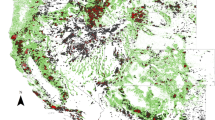Abstract
Although an increasing frequency of forest fires has been suggested as a consequence of global warming, there are no empirical data that have shown climatically driven increases in fire frequency since the warming that has followed the end of the “Little Ice Age” (∼1850). In fact, a 300-year fire history (AD 1688–1988) from the Lac Duparquet area (48°28′N, 79°17′W) shows a significant decrease both in the number and extent of fires starting 100 years ago during a period of warming. To explore this relationship between climatic change and fire frequency we used daily data from the Canadian Atmospheric Environment Service's General Circulation Model to calculate components of the Canadian Forest Fire Weather Index (FWI) System for the 1xCO2 and 2xCO2 scenarios. The average FWI over much of eastern Canada, including the Lac Duparquet region, decreased under the 2xCO2 simulation, whereas FWI increased dramatically over western Canada. According to these results, fire frequency would decrease over the southeastern boreal forest which is in agreement with the empirical data from the fire history. Our results stress the importance of large regional variability and call into question previous generalisations suggesting universal increases in the rate of disturbance with climate warming.
Similar content being viewed by others
References
Archambault, S. and Bergeron, Y.: 1992.Can. J. For. Res. 22, 674–682.
Bergeron, Y.: 1991.Ecology 72, 1980–1992.
Bergeron, Y. and Archambault, S.: 1993.The Holocene 3, 255–259.
Bergeron, Y. and Dubuc, M.: 1989.Vegetatio 79, 51–63.
Boden, T. A., Kanciruk, P. and Farrell, M. P.: 1990.Trends '90: A Compendium of Data on Global Change. ORNL/CDIAC-36. Department of Energy. Washington D.C., USA.
Boer, G. J., McFarlane, N. A. and Lazare, M.: 1992.J. Climate 5, 1045–1077.
Clark, J. S.: 1988.Nature 334, 233–235.
Clark, J. S. 1990.Ecol. Monogrphs 60, 135–159.
Cwynar, L. C.: 1977.Can. J. Bot. 55, 1524–1538.
Environment Canada: 1992.The State of Canada's climate: Temperature Change in Canada 1895–1991. State of the Environment Report No. 92–2. Environment Canada, Ottawa, Canada. 36 pp.
Filion, L.: 1984.Nature.309, 543–546.
Flannigan, M. D. and Harrington, J. B.: 1988.J. Appl. Meteorol. 27, 441–452.
Flannigan, M. D. and Van Wagner, C. E.: 1991.Can. J. For. Res. 21, 66–72.
Fritts, H. C.: 1991,Reconstructing large-scale climate patterns from tree-ring data. University of Arizona Press, Tucson, USA.
Harrington, J. B.: 1982,A statistical study of area burned by wildfire in Canada 1953–80. Canadian Forestry Service Information Report PI-X-16. Petawawa National Forest Institute, Chalk River, Canada. 32 pp.
Harrington, J. B., Flannigan, M. D. and Van Wagner, C. E. 1983,A study of the relation of components of the Fire Weather Index to monthly provincial area burned by wildfire in Canada 1953–80. Canadian Forestry Service Information Report PI-X-25. Petawawa National Forest Institute, Chalk River, Canada. 65 pp.
Heinselman, M. L.: 1973,Quaternary Res. 3, 329–382.
Higgins, D. G. and Ramsey, G. S.: 1992,Canadian Forest Fire Statistics. Canadian Forest Service Information Report PI-X-107E/F. Petawawa National Forest Institute, Chalk River, Canada.
Johnson, E. A. and Larsen, C. P. S.: 1991,Ecology 72, 194–201.
Liu, Kam-Biu.: 1990,Ecol. Monographs 60, 179–212.
Luckman, B. H.: 1988,Arctic and Alpine Res. 11, 52–77.
Luckman, B. H. and Osborne, G. D.: 1979,Quaternary Res. 11, 52–77.
McFarlane, N. A., Boer, G. J., Blanchet, J.-P., and Lazare, M.: 1992,J. Climate 5, 1013–1044.
Newark, M. J.: 1975,Atmosphere 13, 26–33.
Overpeck, J. T., Rind, D. and Goldberg, R.: 1990,343, 51–53.
Payette, S.: 1992, In: Shugart, H. H., Leemans, R. and Bonan, G. B. (eds.).A Ssystems Analysis of the Boreal Forest. Cambridge University Press. Cambridge, UK.
Payette, S., Filion, L., Gauthier, L., and Boutin, Y.: 1985,Nature 315, 135–138.
Rizzo, B. and Wiken, E., 1992.Climatic Change 21, 37–55.
Rutter, A. J.: 1975, In: Monteith, J. L. (ed.).Vegetation and the Atmosphere: Vol. 1, Principles, Academic Press, New York, USA.
Scott, P. A., Hansell, R. I. C. and Fayle, D. C. F.: 1987,Arctic and Alpine Res. 19, 45–51.
Solomon, A. M.: 1986.Oecologia 68, 567–579.
Simard, A. J.: 1973,Forest fire weather zones of Canada. Environment Canada, Forestry Service. Map with text.
Van Wagner, C. E.: 1987,Can. For. Serv. For. Tech. Rep. 35.
Van Wagner, C. E.: 1988,For. Chron. 64, 182–185.
Author information
Authors and Affiliations
Rights and permissions
About this article
Cite this article
Bergeron, Y., Flannigan, M.D. Predicting the effects of climate change on fire frequency in the southeastern Canadian boreal forest. Water Air Soil Pollut 82, 437–444 (1995). https://doi.org/10.1007/BF01182853
Issue Date:
DOI: https://doi.org/10.1007/BF01182853




